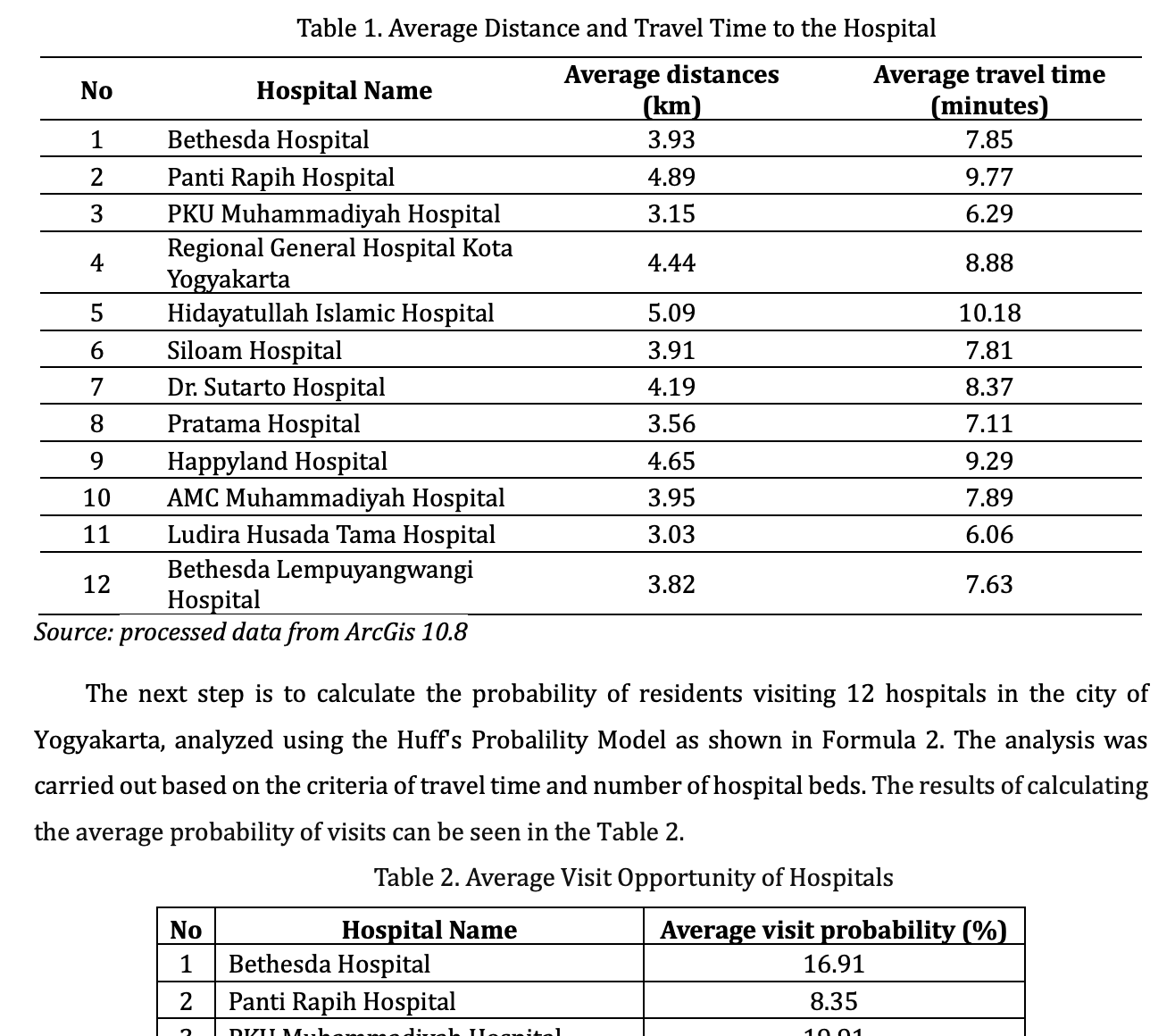A Study of Hospital Competition in Yogyakarta City with Huff’s Gravity Model and Valuation Methods
DOI:
https://doi.org/10.12928/jampe.v3i1.8922Keywords:
Hospital , Huff’s Gravity Model , Potential Value , Valuation MethodAbstract
This analysis was conducted to identify the level of hospital competition in Yogyakarta City. The object of this study is 12 hospitals in Yogyakarta City. The analytical tools in this study consist of two methods. The ?irst method is the Huff’s Gravity Model used to estimate the probability of visits to each hospital so that the competition between hospitals can be known. The second method is the valuation method using the income approach to calculate the potential value of the hospital. The results of this study show that the largest visit probability and potential value are owned by RS PKU Muhammadiyah Yogyakarta with a probability value of 19.91% and a potential value of IDR 8,493,747,933,578 for an optimistic estimate, IDR 3,370,534,894,277 for a moderate estimate, and IDR 1,400,068,340,700 pessimistic estimate. The contribution of this research can be considered in making investment decisions, especially in planning the establishment of a new hospital or expanding the capacity of an existing hospital. For investors who will invest in the hospital industry, they should look for locations that are easily accessible and avoid building hospitals with lower types near hospitals with high types; this will affect the level of probability of visits to the hospital itself. If the level of visit opportunity is low, then the potential value that will be obtained will also be low.
References
Anderson, J. E. (2010). The gravity model. Natl Bur Econ Res, 170–192.
Braeye, T., Quoilin, S., & Hens, N. (2019). Incidence estimation from sentinel surveillance data; A simulation study and application to data from the Belgian laboratory sentinel surveillance. BMC Public Health, 19(1), 1–18. https://doi.org/10.1186/s12889-019-7279-y
Drezner, T., & Drezner, Z. (2002). Validating the Gravity-Based Competitive Location Model Using Inferred Attractiveness. Annals of Operations Research, 111(1), 227–237. https://doi.org/10.1023/A:1020910021280
Fortney, J., Rost, K., & Warren, J. (2000). Comparing Alterative Methods of Measuring Geographic Access to Health Services. Health Services and Outcomes Research Methodology, 1(2), 172–184. https://doi.org/10.1023/A:1012545106828
Harjanto, B. (2001). Retail Market Analysis Terhadap Beberapa Pusat Perbelanjaan di Kota Semarang. Jurnal Survai & Penilaian Properti, 20, 9–20.
Harjanto, B. (2006). Kapitalisasi Berbagai Jenis Penggunaan Properti dalam Rangka Penentuan Zona Nilai Tanah di Kota Yogyakarta. Pascasarjana Universitas Gadjah Mada.
Hidayat, D. (2006). Analisis Wilayah Cakupan Pusat Perbelanjaan di Kota Denpasar. Program Pascasarjana UGM. Yogyakarta.
Huang, J., Chen, Y., Liu, G., Tu, W., Bergquist, R., P Ward, M., … Zhang, Z. (2023). Optimizing allocation of colorectal cancer screening hospitals in Shanghai: a geospatial analysis. Geospatial Health, 18(2), 1–9. https://doi.org/10.4081/gh.2023.1152
Huff, D. L. (1963). A Probabilistic Analysis of Shopping Center Trade Areas. Land Economics, 39(1), 81–90. https://doi.org/10.2307/3144521
Huff, D. L. (1964). Defining and Estimating a Trading Area. Journal of Marketing, 28(3), 34–38. https://doi.org/https://doi.org/10.2307/1249154
Huff, D. L. (2000). Don’t misuse the Huff Model in GIS. Business Geographies, 8(8), 12.
Jia, P., Xierali, I. M., & Wang, F. (2015). Evaluating and re-demarcating the Hospital Service Areas in Florida. Applied Geography, 60, 248–253. https://doi.org/10.1016/j.apgeog.2014.10.008
Lowe, J. M., & Sen, A. (1996). Gravity model applications in health planning: Analysis of an urban hospital market. Journal of Regional Science, 36(3), 437–461. https://doi.org/10.1111/j.1467-9787.1996.tb01111.x
Lubis, Try Citra Puspitasari. (2022). Journal of Asset Management and Public Economy (JAMPE). Competitiveness Strategy in Facing Sustainable Economic Development on Social Economic Basis in Indonesia, 2(1), 18-34. https://doi.org/10.12928/jampe.v1i2.5926
Luo, W., & Qi, Y. (2009). An enhanced two-step floating catchment area (E2SFCA) method for measuring spatial accessibility to primary care physicians. Health and Place, 15(4), 1100–1107. https://doi.org/10.1016/j.healthplace.2009.06.002
Lv, H. R., Bai, X. X., Yin, W. J., & Dong, J. (2008). Simulation Based Sales Forecasting on Retail Small Stores. Winter Simulation Conference, 1711–1716. https://doi.org/10.1109/WSC.2008.473625
Mitrikova, J., & Antolikova, S. (2016). Calculation of shopping probability by the Huff model in selected retail stores of Kosice (Slovak Republic). Economic Annals-XXI, 159(5–6), 63–66. https://doi.org/10.21003/ea.V159-13
Park, C., Ko, Y., Youn, M., & Kim, W. (2006). Prediction of Estimated Sales Amount through New Open of Department Store. Journal of Distribution Science, 4(2), 5–20.
Reilly, W. J. (1931). The law of retail gravitation. New York: Knickerbocker Press.
Rozak, A. M., & Ariastita, P. G. (2013). Pola spatial persebaran pusat perbelanjaan modern di Surabaya berdasarkan probabilitas kunjungan. Jurnal Teknik POMITS, 2(2), 234–238. https://doi.org/10.12962/j23373539.v2i2.3943
Sekaran, U. (2013). Research Methods For Business 3rd edition. New York: John Wiley & Sons, Inc.
Suhara, Y., Bahrami, M., Bozkaya, B., & Pentland, A. S. (2021). Validating Gravity-Based Market Share Models Using Large-Scale Transactional Data. Big Data, 9(3), 188–202. https://doi.org/10.1089/big.2020.0161
Tao, Z., & Cheng, Y. (2014). Measuring spatial accessibility to residential care facilities in Beijing. Progress in Geography, 33, 616–624. https://doi.org/10.11820/dlkxjz.2014.05.003
Tao, Z., & Cheng, Y. (2019). Modelling the spatial accessibility of the elderly to healthcare services in Beijing, China. Environment and Planning B: Urban Analytics and City Science, 46(6), 1132–1147. https://doi.org/10.1177/2399808318755145
Todaro, M., & Smith, S. C. (2015). Economic Development (12th ed.). Pearson.
Victoor, A., Delnoij, D. M., Friele, R. D., & Rademakers, J. J. (2012). Determinants of patient choice of healthcare providers: A scoping review. BMC Health Services Research, 12(1). https://doi.org/10.1186/1472-6963-12-272
Weinhold, I., Wende, D., Schrey, C., Militzer-Horstmann, C., Schang, L., & Sundmacher, L. (2022). Assessing Patients’ Acceptable and Realised Distances to Determine Accessibility Standards for The Size of Catchment Areas in Outpatient Care. Health Policy, 126(11), 1180–1186. https://doi.org/https://doi.org/10.1016/j.healthpol.2022.08.011
Woo, A. S., Lee, S., Jin, K. P., & Youn, M. (2009). A Practical Study on the New Revenue Estimate Model Of SSM. Journal of Distribution Science, 7(3), 5–24. https://doi.org/10.15722/jds.7.3.200909.5
Youn, M.-K. (2012). Retail sales forecast analysis of general hospitals in Daejeon, Korea, using the Huff model. African Journal of Business Management, 6(3), 971–977. https://doi.org/10.5897/ajbm11.1525
Zhang, P., Ren, X., Zhang, Q., He, J., & Chen, Y. (2015). Spatial Analysis of Rural Medical Facilities Using Huff Model: A Case Study of Lankao County, Henan Province. International Journal of Smart Home, 9(1), 161–168. https://doi.org/https://doi.org/10.14257/ijsh.2015.9.1.17

Downloads
Published
Issue
Section
License
Copyright (c) 2024 Isabel Vieira, Gea Dwi Asmara

This work is licensed under a Creative Commons Attribution-ShareAlike 4.0 International License.










